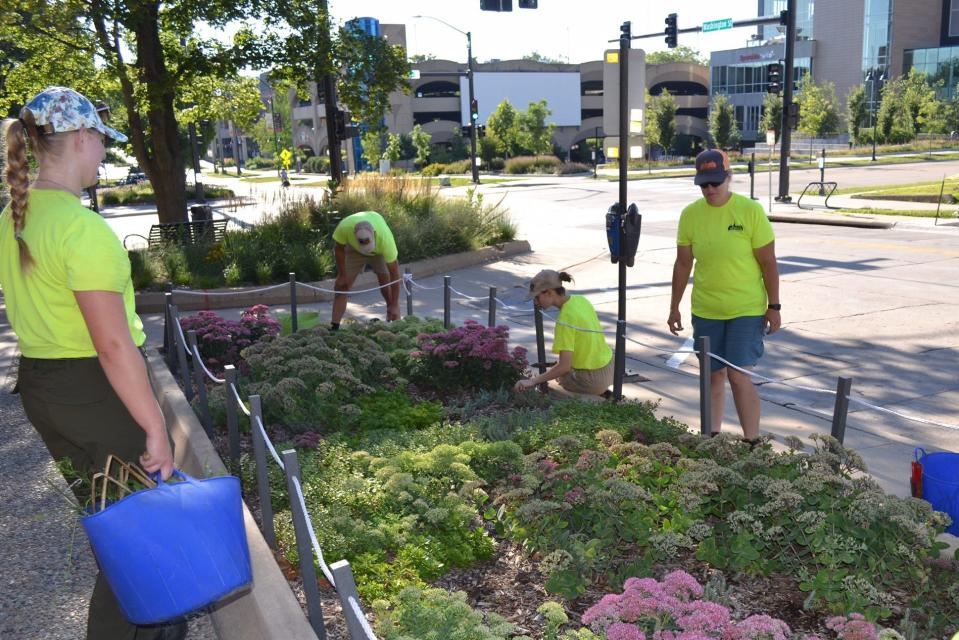Native plants bring balance back to nature as Iowa City strives for climate success
Editor's note: This column is filling in for a vacationing Judy Terry. The focus this week is on Iowa City’s efforts to reduce greenhouse gases with plants.
The most recent program in the Green Plant series, Human Worlds (episode 5), narrated by Sir David Attenborough, explored how humans are helping plants survive.
“Our relationship with plants has changed throughout history,” he explained. “Plants are, after all, our most ancient allies and together we can make this an even greener planet.”
Iowa City would agree. To align with the Paris Climate Agreement, the Climate Action and Adaptation Plan was adopted in 2018 though planning started a decade earlier.
A year after its adoption, the City Council amended the blueprint with Accelerating Iowa City’s Climate Actions. This bolder vision identifies 64 actions to reduce community-wide greenhouse gases — 45% by 2030 and achieve “net zero” by 2050. Climate Action coordinator Sarah Gardner says the city is one of three in Iowa to have a plan in place. (Dubuque and Cedar Rapids also have plans; Ames and Des Moines are forming plans.)
The detailed documents address numerous factors that impact humans — increased temperatures, precipitation and seasonal fluctuations, as well as the ecosystem of plants, animals and insects.
Proper land management will move the city to achieve its goals. Increasing Iowa City’s tree canopy and diversity, and adding native plants are targets.
Between the 2006 F2 tornado, 2020 derecho and the emerald ash borer, Iowa City lost a portion of its tree canopy. Iowa City Superintendent of Parks and Forestry Tyler Baird said tree mortality from the emerald ash borer, detected in Johnson County five or six years ago, is now noticeably visible. To offset losses, the city plans to double the number of trees planted in parklands and right-of-ways to 800 each year.

Gardner said, during photosynthesis, trees remove carbon dioxide from the air while releasing oxygen, and storing the carbon in the tree canopy and underground and trees increase comfort by providing shade.
Now in its third year, the city’s “Root for Trees” program allows residents and businesses to receive a voucher, redeemable at Earl May Nursery and Iowa City Landscaping, for up to 50% off the cost of the purchase price of one tree (up to $125 for a $250 tree) planted on private property. Apply for the voucher online, from September to May, through the city’s Climate Action division.
Another factor helping offset climate warming is planting more perennials in public spaces. In 2015, the city began incorporating natives in its landscape design.
Initially, the focus was on the city’s central business district. The shift brought attention to and redefined the city’s urban gardens and public spaces.
Baird looks for perennial features and native grasses that change throughout the season. As the plants grow and new patterns evolve, the gardens reflect movement and color.
The city’s first project repaired the median on Washington Street after a historic home was moved. To repair the damage, the solution was to convert the area into a prairie instead of replacing grass that must be continually mowed.
“We started with small city projects and redesigned using natives and built from there,” Baird said.

Next, crews restyled the plantings at City Hall. The Robert A. Lee Recreation Center was also redressed with natives to replace foundation plantings and shrubs that had aged out or had become too large for the space.
Clinton Street, reconfigured to accommodate a bike path near Burlington Street, provided another opportunity and a small spot to incorporate a prairie design. Planting successes moved crews to Iowa Avenue to prep the area for redesign during the coronavirus pandemic. There, staff selected grasses to complement the conifer shrubs.
Smaller parks have also been reformed with natives to add beauty and appeal to the neighborhood.
Designing for the downtown is challenging.
Non-natives that behave well and augment the prairie meadow style are also used.
“The goal is to have early spring through fall blooms for pollinators. The majority of our plantings represent 60% natives," Baird said, adding that it’s sometimes difficult to find natives for shady areas that will grow in a tough urban environment.
Each year and each project has enhanced the city’s visual beauty.
"Nothing is permanent, so we can make adjustments," Baird said. "If we have plants left over from one project, they can be planted elsewhere. Our crews have done a good job using their artistic eye to place them in other areas.”
Signs identifying “Prairies in Progress” plots can be found around Iowa City. Because they store most of their carbon underground, prairies are even more reliable “carbon sinks” than forests, according to Iowa City’s Sustainability August newsletter.
About 150 acres of prairie along the Iowa River and creekbeds have been added in the last three years, bringing the city’s total prairie area to 400-plus acres.
Baird said, “In addition to enhancing the city’s aesthetics and bird habitat, these areas reduce mowing that must be performed every year (along with fuel consumption that adds greenhouse gases).
“The city’s tree canopy and prairies all work together to add shade, reduce runoff as well as provide carbon sequestration to meet our climate goals to make certain Iowa City is a beautiful, livable city.”
This article originally appeared on Iowa City Press-Citizen: In Iowa City, native plants bring balance back to nature

